The SOLO Taxonomy #tcea #tceajmg

Infographic created by author in Canva.
A taxonomy of learning can be helpful. It can provide a schema for understanding learning we participate in or facilitate for others. The SOLO Taxonomy has been around since I graduated from eighth grade. In spite of that, I never learned about John Biggs and Kevin Collis’ creation in 1982. It needs little introduction since heavyweights like Peter DeWitt and Pam Hook have spent some time explaining it. Yet, as I mentioned, it’s important to build one’s own theory of understanding. To do so, I have juxtaposed various explanations. These explanations are organized in a simple table.
Online Course: Cybersecurity for Educators #tcea #tceajmg
🔒 Become a Data Guardian! Learn to safeguard sensitive info, encrypt data, protect passwords, and secure your devices and cloud content. Essential for every tech professional.
👉 tcea.org/courses/data-guardian/
Prompt Example: A List of Prompt Libraries and Online Prompt Generators

Need inspiration for prompts? Explore these prompt libraries and prompt generators:
Prompt Libraries
These prompt libraries offer a wide range of resources for you to use AI tools in various aspects of teaching, lesson planning, and administrative tasks.
| Library Title | Description |
|---|---|
| AI for Education GenAI Prompt Library | Offers over 100 AI prompts for educators, organized into categories such as Administrative, Assessment, Communication, Lesson Planning, Professional Development, and more[1][3]. |
| More Useful Things Prompt Library | Run by Dr. Ethan Mollick and Dr. Lilach Mollick, this library provides prompts categorized into Instructor Aids, Student Exercises, and Other Prompts[3]. |
| AI Prompt Library | Features interactive templates for assessments, lesson plans, writing prompts, rubrics, summarizing articles, and feedback. Allows customization based on grade level, subject, and objectives[3]. |
| The Little Book of Generative AI Prompts | Provided by Mark Anderson, this collection organizes prompts by subject, including English, Math, Science, World Language, History, and more. Each subject includes prompts for Workload Reduction, Resource Creation, Lesson Planning, and Quiz Creation[3]. |
| Groovy Education Educator Prompt Library | Offered by William Grube, this library includes dozens of well-crafted prompt templates for creating real-world scenarios, guided questions, grading rubrics, effective emails, lesson plans, icebreaker activities, and more[3]. |
| Microsoft Prompts for Education | A prompt library provided by Microsoft to guide users in using GPT. It covers prompts for administration, educators, staff, and students, offering ideas for generating content with Generative AI tools in different contexts[5]. |
Prompt Generators
| Tool Title | Description |
|---|---|
| Academic Prompt Architect | A tool designed specifically for educators to create customized AI prompts. It allows users to select the type of task, subject area, and other parameters to generate prompts tailored for academic use[1]. |
| AI Text Prompt Generator | Ideal for beginners using AI art tools like MidJourney and Stable Diffusion. It allows users to input a base prompt and refine it with various options, helping users learn prompt engineering through practice. |
| Coefficient AI Prompt Generator | A free tool specifically designed to generate prompts for ChatGPT. It focuses on creating clear and specific prompts for both text and spreadsheet formula generation. |
| Easy-Peasy.ai Prompt Generator | Specializes in improving image prompts for AI art generation. It offers a user-friendly interface and helps users create more detailed and effective prompts for various AI art tools. |
| Feedough AI Prompt Generator | A free tool that uses pre-trained systems to quickly generate effective prompts for AI generators. It’s designed to help users create prompts that AI tools can accurately interpret and act upon. |
| Originality.ai Prompt Generator | A free, easy-to-use tool that generates creative and engaging prompts. It’s designed to stimulate creativity, help overcome writer’s block, and provide fresh perspectives for various writing projects. |
| Picsart AI Prompt Generator | A versatile free tool that can generate prompts for text, images, videos, and code. It’s useful for various professionals including bloggers, students, entrepreneurs, and marketers. |
| PromptPerfect | Considered the best overall AI prompt generator, it creates prompts for multiple AI tools including ChatGPT, Stable Diffusion, MidJourney, and more. It offers detailed, specific, and actionable prompts with explanations of optimizations made. |
| Prompter | A popular free AI prompt generator tool that helps users create effective prompts for various AI applications. |
| Taskade AI Prompt Generator | An AI-driven tool that generates prompts tailored to specific needs and preferences. It can create various types of prompts, including zero-shot and multi-shot, for writers, bloggers, programmers, and students. |
Special Tool - Academic Prompt Architect
- This is one of my creations. I had so much fun making it via ChatGPT CustomGPT.
- I love it that you can ask it to format prompts using prompt acronyms:
AI Prompt Acronyms
| Acronym | Description |
| APE | State the [Action], Create a [Purpose], Describe [Expectation] |
| BAB | Explain Problem [Before], State the Goal [Task], Ask for Output [Format] |
| CARE | Give the [Context], Describe [Action], State [Results], Give the [Example] |
| CAPE | Comprehend, Articulate, Perform, Evaluate |
| CER | Claim, Evidence, Reasoning |
| CLEARER | Claim, Literature/Look for Proof, Examine, Apply, Respond, Elaborate, Recap |
| ERA | Describe [Expectation], Act as a [Role], State the [Action] |
| PEARL | Point, Evidence, Analysis, Reader Response, Link |
| PLAN | Prepare, Leverage, Adapt, Navigate |
| RACE | Specify the [Role], State the [Action], Give the [Context], Specify [Expectation] |
| RETO | Role, Expectation, Task, Output |
| RISE | Specify the [Role], Describe the [Input], State the [Steps], Describe [Expectation] |
| RTF | Act as a [Role], Create a [Task], Show as [Format] |
| TAG | Define the [Task], State the [Action], Clarify the [Goal] |
| TCEA | Tone, Context, Examples, Alignment |
Scoring Your Own Prompts
What’s more, you can use the Architect to score your prompt creations with the Meta-Prompt Analysis Rubric, which appears below.
Meta-Prompt Analysis Rubric
Please note that the information in this rubric has been given to ChatGPT Custom GPT, Academic Prompt Architect, along with TCEA blog entries by Miguel Guhlin that are pending publication at some undisclosed future date. Feel free to adapt this rubric for your own use under CC-BY-SA.
Rubric
| # | Component | Explanation | 1 | 2 | 3 | Example (3 points) |
| 1 | Role Assignment | Defining AI's persona or expertise | No role specified | Basic role | Detailed persona described | "As an experienced elementary school art teacher, suggest five age-appropriate painting activities for 2nd graders." |
| 2 | Goal Setting | Whether a clear objective is stated | No clear goal | Partial objective | Well-defined goal | "Create a lesson plan on photosynthesis for 7th graders that includes a hands-on experiment." |
| 3 | Background Info | Provision of necessary context | No context | Some context | Comprehensive context | "Design a math worksheet for 5th graders who have just learned long division but struggle with remainders." |
| 4 | Clarity | How clear and unambiguous the prompt is | Vague or confusing | Somewhat clear | Crystal clear | "Explain the water cycle using simple terms and concrete examples suitable for 3rd graders." |
| 5 | Task Breakdown | Division of request into subtasks | No breakdown | Some division | Clear subtasks outlined | "Develop a history project: 1) Choose a historical figure, 2) Create a timeline, 3) Write a short biography, 4) Design a poster." |
| 6 | Boundaries | Clear inclusion/exclusion criteria | No criteria | Some limitations | Clear boundaries set | "Write a book report guide for 6th graders, focusing on plot and character analysis. Exclude advanced literary devices." |
| 7 | Output Structure | Specification of desired format | No format mentioned | Format hinted | Detailed format instructions | "Create a Mermaid diagram showing the steps of the scientific method for a high school biology class." |
| 8 | Scope | Indication of desired response length | No length mentioned | Rough estimate | Precise length specified | "Write a 500-word essay on climate change suitable for 9th grade students." |
| 9 | Exemplification | Provision of examples or samples | No examples | Basic example | Multiple relevant examples | "Provide three sample thesis statements for an 8th grade persuasive essay on the importance of recycling." |
| 10 | Flexibility | Room for creative interpretation | Overly restrictive | Some flexibility | Encourages creativity | "Design a creative writing prompt for 4th graders that incorporates elements of fantasy and everyday life." |
| 11 | Feedback Loop | Request for output evaluation | No review asked | Basic check | Comprehensive review criteria | "Create a rubric for evaluating 10th grade oral presentations, including criteria for content, delivery, and visual aids." |
| 12 | Troubleshooting | Guidance for handling errors | No error handling | Basic error mention | Detailed error resolution steps | "Develop a math problem-solving guide for 6th graders, including common mistakes and how to correct them." |
All-encompassing prompt example:
“As an experienced high school English teacher specializing in creative writing, your task is to develop a comprehensive, engaging lesson plan for a 10th-grade class on the art of storytelling. The students have a basic understanding of narrative elements but struggle with creating compelling characters and maintaining narrative tension.
Your objective is to create a week-long unit that will improve students' storytelling skills, focusing on character development and plot structure. The unit should culminate in students writing their own short stories.
Please structure your lesson plan as follows:
- Outline five 50-minute lessons, one for each day of the week
- For each lesson, provide: a) A clear learning objective b) A warm-up activity (5-10 minutes) c) Main instructional content (25-30 minutes) d) A student practice activity (10-15 minutes) e) A wrap-up or reflection (5 minutes)
- Include a list of required materials for each lesson
- Suggest one homework assignment for each day, building towards the final short story
Ensure that the lessons incorporate a variety of teaching methods, including direct instruction, group discussions, peer reviews, and individual writing time. Include at least one multimedia element, such as a video clip or audio recording, to illustrate effective storytelling techniques.
The final lesson should guide students in starting their short stories, which should be 1000-1500 words long. Provide a clear rubric for assessing these stories, focusing on character development, plot structure, narrative tension, and creative use of language.
While the lessons should follow a logical progression, allow for flexibility to adapt to student needs and interests. Include suggestions for differentiation to support struggling writers and challenge advanced students.
Please present your lesson plan in a clear, easy-to-follow format using markdown, with headers for each day and subheaders for lesson components. Include a brief introduction explaining the overall goals of the unit and a conclusion summarizing expected outcomes.
If you encounter any areas where clarification might be needed, please note these and suggest how a teacher might address potential challenges or misconceptions.
Your response should be comprehensive yet concise, aiming for about 1500 words total. Remember to balance creativity with practical, actionable instructional strategies.”
This all-encompassing prompt incorporates all 12 components from the rubric, creating a detailed and well-structured request for a K-12 educational resource.
Meet ALDO: The Amazing Lesson Design Outline #tcea #tceajmg
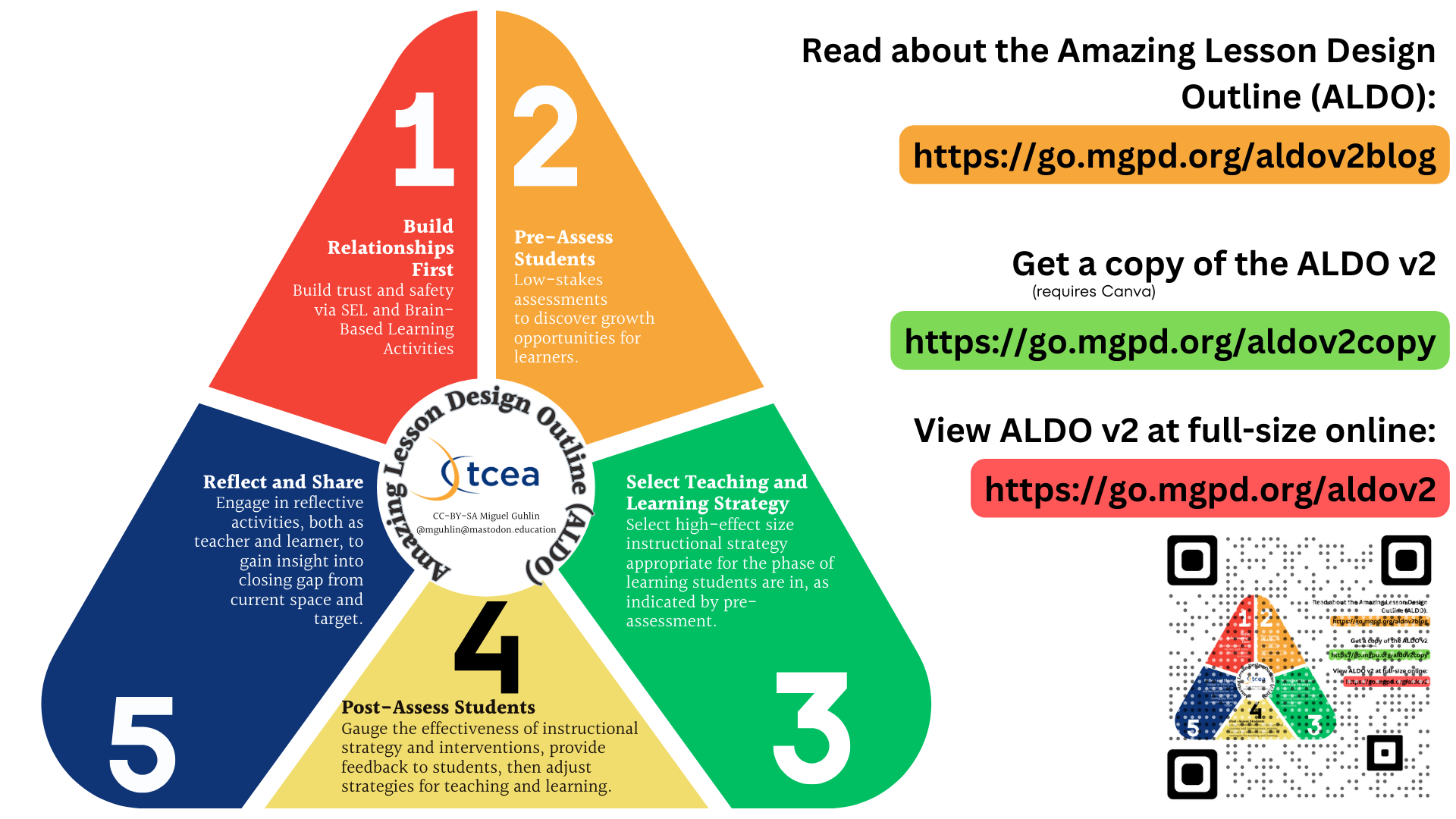
Images created by author.
Ever wish you had an easy-to-follow checklist when designing learning for students? I know I have…often. Some of my colleagues effortlessly design amazing lessons, but I have to plod through each point. But lesson design is something that is critical to ultimate success in the classroom for each student. That’s why I’d like to take a moment to share my latest version of the outline I use. At the end, you will find a custom GPT you can use to get an AI spin on ALDO.
More ALDO Goodness


Online Course: Cultivating Calm #MentalHealth #tcea #tceajmg #yoga
🌿 Cultivate calm with our course! Learn to manage stress, practice focused breathing, and bring peace to your classroom. Empower yourself and your students for a balanced life.
👉 tcea.org/courses/cultivating-calm/
LinkShare: Teaching AI Ethics - Free ebook
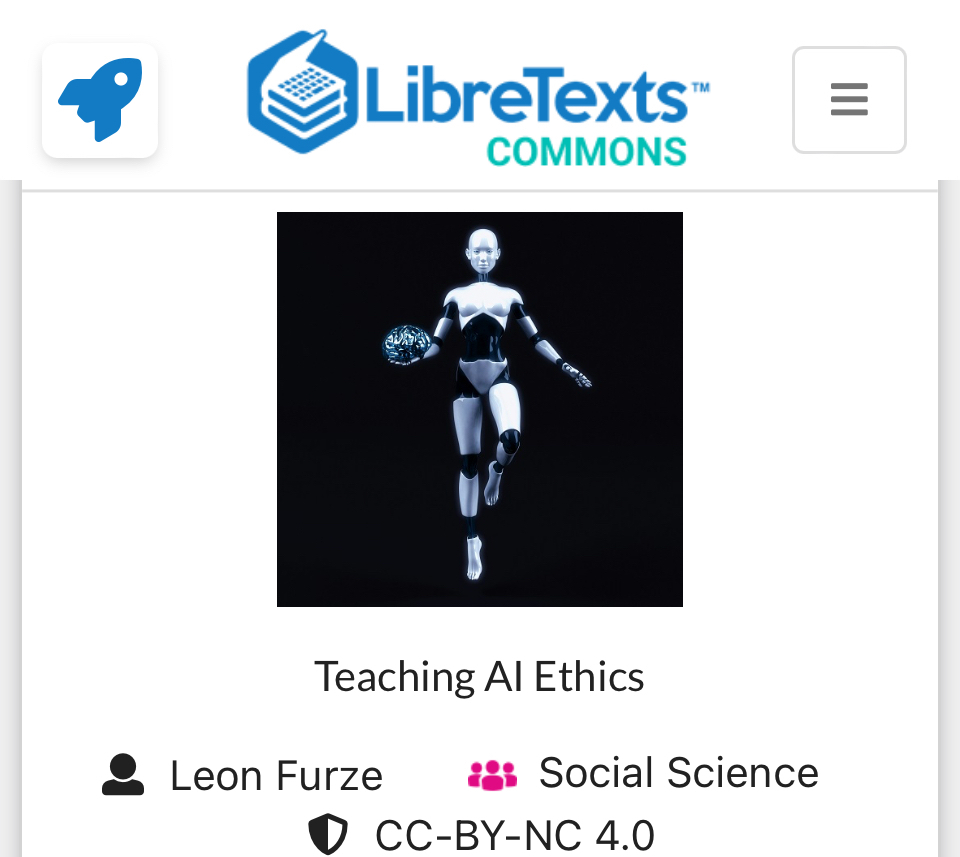
Leon Furze shares a free ebook on Teaching AI Ethics that he wrote…
Open Access book: Teaching AI Ethics
Thanks to Anna Mills and the team at LibreTexts my 2023 collection of articles ‘Teaching AI Ethics’ has been published as an open access book and is now available online.
The materials are free to access and use under a CC BY NC-4.0 license for remixing and sharing with attribution.
Each of the original articles is now a chapter in the online text, and the entire collection is available for download as a PDF book. The book covers the nine areas of ethical concern I highlighted in 2023 and have been discussing since:
- Bias and discrimination
- Environmental concerns
- Truth and academic integrity
- Copyright
- Privacy
- Datafication
- Affect (emotion) recognition
- Human labour
- Power
Each chapter has an overview of the issue, how it applies to the technology, and case studies from the media.
These are followed by suggestions for teaching these issues in a range of disciplines including ELA, Humanities, The Arts, Science, Mathematics, Design, and Health.
Get it online
Micro-Reflections: Crafting Reflections in the Moment #tcea #tceajmg
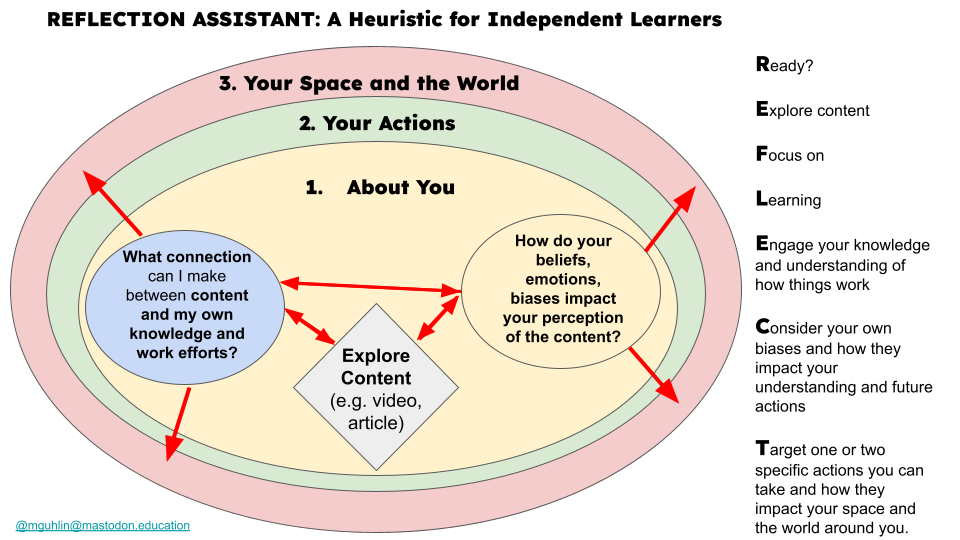
Get a copy of all images shown via Google Slides. Inspired by The Actiope Model. [Learn more online.](https://blog.tcea.org/micro-reflections/)
Want to get the most out of what you learn? You may be missing out on an important step – reflection! Here’s a heuristic to make it easier. How do you reflect on your daily work? Reflection can be a bit daunting. After a long day’s work, you may stagger home, plop on the couch, and pass out. You know reflecting on your day is important, but waiting until the day’s end is too hard.
How to Create a Rubric with #ChatGPT #tcea #tceajmg #AI
Get an editable prompt template and create a rubric with ChatGPT in less than one minute! Watch it work its magic in an example video. As educators, we all know and appreciate the importance of the rubric in providing quality student assessment and feedback. But actually creating a solid rubric that’s clear, aligns with the curriculum, and is well-structured can be daunting and, let’s be real, time consuming. If you’re like me, rubrics are perfect for overthinking. I’ll build one, and then continue to refine and adapt to “improve it,” in hopes of making it airtight. But then, I look at the clock to realize hours have passed. Can this be avoided? Yes. Thank goodness! You can create a rubric with ChatGPT in less than a minute and free up precious time for other priorities.
Online Course: Creative Response to Literature #tcea #tceajmg
📚 Elevate literacy with our “Creative Response to Literature” course! Empower students to share unique perspectives and enhance reading comprehension across all subjects and grade levels.
👉 tcea.org/courses/creative-response-to-literature/
Prompt Examples: Education Focused
| Function | Description | Sample Prompt |
|---|---|---|
| 3D Science Evaluator | Create a 3D science assessment based on NGSS or new Science TEKS. | “Design a comprehensive three-dimensional science assessment for a middle school unit on ecosystems, aligning it with [NGSS] or [new Science TEKS]. Ensure the assessment includes tasks that evaluate disciplinary core ideas, science and engineering practices, and crosscutting concepts.” |
| 5E Lesson Designer | Create a science lesson using the 5E instructional model. | “Develop a detailed 5E lesson plan on [SCIENCE TOPIC] for grade [LEVEL]. Outline an engaging activity to Engage, a hands-on experiment or investigation to Explore, direct instruction to Explain, an extension activity to Elaborate, and an assessment task to Evaluate students' understanding. Ensure the entire lesson is designed for a 60-minute class period.” |
| Academic Content Maker | Produce custom academic content based on specified criteria. | “Create a comprehensive study guide on [TOPIC] for my [COURSE NAME] students. Summarize the key concepts from [CHAPTERS/UNITS] and organize the information using bullet points and tables for clarity and ease of understanding.” |
| Accommodation Advisor | Suggest accommodations for students needing support. | “I have a student with [LEARNING DISABILITY/CHALLENGE]. Suggest a variety of accommodations to support their learning and success in the classroom, including instructional adjustments, assessment modifications, environmental changes, and social-emotional support strategies.” |
| AI-Proof Assignments | Get ideas for making assignments AI-proof. | “How can I design a challenging and engaging assignment on Shakespeare’s ‘Hamlet’ that is resistant to AI chatbot completion? Consider incorporating open-ended questions, creative tasks, and requirements for original analysis.” |
| Appreciation Composer | Write an appreciation note. | “Draft a heartfelt thank you note to [PERSON] for [REASON]. Express sincere appreciation and highlight [SPECIFIC THING] that you are particularly grateful for. Ensure the tone is warm and genuine.” |
| Assignment Decomposer | Break down an assignment into manageable steps. | “Here is an assignment I want to scaffold for my students: [DESCRIBE ASSIGNMENT]. Break it down into 5-6 manageable steps or sub-tasks, and provide a suggested timeline or checkpoints to help students stay on track and complete it independently.” |
| Behavior Intervention Strategist | Recommend behavior interventions based on observed student behaviors. | “I have a student who is struggling with these behaviors: [DESCRIBE BEHAVIORS]. What are some effective strategies I can implement to support the student in developing positive behaviors? Consider class-wide preventive practices, targeted interventions, and response strategies for when challenging behaviors occur.” |
| Behavior Contract Crafter | Generate a Student Behavior Contract. | “Create a Student Behavior Contract for a student exhibiting [list of behaviors], who may also have [conditions such as ADHD]. Include clear expectations, consequences, and rewards, and ensure the contract is tailored to the student’s specific needs and challenges.” |
| Choice Board Architect | Design a choice board aligned with UDL principles. | “Design a UDL-aligned choice board for a [SUBJECT/TOPIC] assignment. Include 9 options that allow students to demonstrate their learning in various formats and media, with varying levels of complexity to support all learners. Ensure each option assesses the same key objectives: [LIST OBJECTIVES].” |
| Clarity Enhancer | Clarify and simplify instructions for students. | “Rewrite these instructions to make them clearer and more concise for 5th-grade students: [insert instructions]. Focus on using simple language, short sentences, and clear directives.” |
| Coach’s Practice Planner | Plan a sports practice session. | “Create a one-hour soccer practice plan for 10-year-olds. Include a warm-up, skill drills, a small-sided game, and a cool-down, ensuring the session is both engaging and developmentally appropriate.” |
| Concept Connector | Brainstorm ways to make content relevant to students. | “Generate ideas to make a lesson on the water cycle relevant and engaging for high school students. Consider connections to real-world issues, local environments, and student interests.” |
| Conceptual Understanding Builder | Suggest ways to build conceptual understanding. | “Provide strategies to help students develop a deep conceptual understanding of algebra. Consider methods like visual representations, real-life applications, and scaffolded problem-solving activities.” |
| Content Translator | Write a family update email in multiple languages. | “Draft a concise email update to inform my students' families about [TOPIC/EVENT]. The email should be 2-3 short paragraphs, highlighting key points. Then, translate the email into [LANGUAGE].” |
| Copyedit Text | Proofread and edit text. | “Proofread and edit the following text for spelling, grammar, and punctuation errors. Also, improve clarity and conciseness where needed: [PASTE TEXT].” |
| Custom Chatbot Maker | Create a chatbot based on custom criteria. | “Create an AI chatbot to assist [GRADE/SUBJECT] students with [TOPIC]. The chatbot should: [LIST KEY CAPABILITIES, e.g., answer questions, provide explanations, give examples]. It should use a friendly and encouraging tone while breaking down concepts step-by-step as needed.” |
| Data Analysis Designer | Create a data table and questions for analysis. | “Create a data table showing [DESCRIBE DATA SET], and develop 4-5 questions that require students to analyze the data, perform calculations, and draw conclusions. Include an answer key.” |
| Decodable Story Crafter | Write a decodable text to support early literacy. | “Write a short decodable passage for early [GRADE] readers that focuses on the phonics pattern [XYZ]. Use simple, repetitive sentence structures and common sight words. The passage should be 50-80 words long and can be about [TOPIC].” |
| DOK Question Generator | Create questions at different Depth of Knowledge levels. | “Create a series of questions on [TOPIC] spanning the DOK levels: 1 Level 1 question, 2 Level 2 questions, 2 Level 3 questions, and 1 Level 4 question. Provide an answer key.” |
| Email Reply Composer | Compose a reply to an email. | “I received this email from a parent: [PASTE EMAIL]. Draft a professional response that addresses their concerns and questions. Keep the tone positive, empathetic, and concise, aiming for 2-3 paragraphs.” |
| Exemplar Illustrator | Provide exemplar and non-exemplar work samples. | “Here is a writing assignment prompt I gave my [GRADE] students: [PASTE PROMPT]. Generate an exemplar response that fully meets expectations and a non-example that does not. Annotate each response, explaining what makes it strong or weak.” |
| Formative Assessment Creator | Generate a multiple choice assessment. | “Create a 20-question multiple choice assessment on [TOPIC], aligned with the following standards: [LIST STANDARDS]. Each question should have 4 answer choices, and an answer key should be provided.” |
| Gifting Guru | Suggest gift ideas for teachers to give. | “Suggest meaningful gift ideas for a teacher to give to colleagues and students, considering a range of budgets and personal preferences.” |
| Group Activity Designer | Create a group work activity. | “Design a 30-minute collaborative learning activity on [TOPIC] for [GRADE] students working in groups of 3-4. The activity should be engaging and hands-on, addressing the learning objective: [STATE OBJECTIVE]. Provide clear instructions for each group and specify the expected deliverable.” |
| IEP Drafter | Draft an Individualized Education Program. | “Generate a draft IEP for a [GRADE] student with [DISABILITY]. The IEP should include goals and accommodations in the areas of [NEED AREAS]. Use standard IEP language and format.” |
| Informational Text Composer | Write a custom informational text. | “Write a 500-word informational article for [GRADE LEVEL] students on [TOPIC]. Explain key concepts using student-friendly language and include relevant examples, diagrams, or illustrations.” |
| Jeopardy Game Maker | Make a Jeopardy-style review game. | “Create a Jeopardy-style review game for my [SUBJECT/UNIT] class. Develop 5 categories, each with 4 questions of increasing difficulty. Ensure the questions assess key topics: [LIST KEY TOPICS]. Provide answers in the form of a question.” |
| Lab Investigation Designer | Design a science investigation. | “Design a hands-on science investigation for [GRADE] on [TOPIC], aligned with the standard: [PASTE STANDARD]. The lab should take 30-45 minutes and use readily available materials. Include a materials list, procedures, and 3-4 follow-up questions for students to answer.” |
| Lesson Plan Crafter | Develop a lesson plan. | “Create a 60-minute lesson plan for teaching [TOPIC] to [GRADE LEVEL]. The objective is for students to [OBJECTIVE]. Include an engaging introduction, direct instruction, guided practice, and independent practice.” |
| Letter of Recommendation Writer | Draft a letter of recommendation. | “I’m |
writing a college recommendation letter for a student. Here are key details about their academic record, character traits, accomplishments, and my relationship with them: [LIST DETAILS]. Draft a compelling letter that highlights their strengths and explains why they would be a great fit for [COLLEGE NAME].” | | Math Review Spiraler | Create a spiral review of math problems. | “Create a 10-question math spiral review for [GRADE] covering the following topics: [LIST TOPICS]. Include questions in a variety of formats (multiple choice, fill-in-the-blank, short answer) and difficulty levels. Provide an answer key.” | | Math Storyteller | Compose a math word problem with a story context. | “Create an engaging word problem for [GRADE] students to practice [MATH CONCEPT]. Set the problem within a story about [TOPIC], requiring the use of [SKILL/OPERATION] to solve.” | | Misconception Buster | Identify and address common misconceptions about a topic. | “List common misconceptions about photosynthesis and provide strategies for correcting them.” | | Multilingual Explainer | Provide several ways to explain a concept. | “Explain the concept of [TOPIC] to [GRADE/SUBJECT] students in 2-3 different ways. The explanations should build on prior knowledge, use relatable analogies or examples, and address common misconceptions. Use concise, student-friendly language.” | | PBL Unit Planner | Plan a PBL unit. | “Design a project-based learning (PBL) unit for [GRADE/SUBJECT] on [TOPIC]. Start with the driving question, identify key learning objectives, and outline the major components, deliverables, and timeline for the project. Plan for a 2-3 week unit duration.” | | Professional Email Drafter | Write a professional email. | “Draft a professional email to [RECIPIENT] about [TOPIC]. Use a friendly but respectful tone, keep the message concise, and proofread it for errors before sending.” | | Reading Level Adapter | Adapt a text to a different reading level. | “Adapt this text to an appropriate reading level for [GRADE] students: [PASTE ORIGINAL TEXT]. Simplify vocabulary and sentence structures as needed while preserving the main ideas.” | | Real-World Connector | Give real-world examples connected to content. | “Brainstorm 3-4 real-world examples or applications of [TOPIC] that would help [GRADE/SUBJECT] students understand its importance and connection to their lives. Ensure the examples are age-appropriate and engaging.” | | Recommendation Wordsmith | Draft a letter of recommendation. | “I’m writing a college recommendation letter for a student. Here are key details about their academic record, character traits, accomplishments, and my relationship with them: [LIST DETAILS]. Draft a compelling letter that highlights their strengths and explains why they would be a great fit for [COLLEGE NAME].” | | Report Card Commentator | Produce report card comments. | “Write end-of-term report card comments for a student, highlighting their top strengths and suggesting 2-3 areas they should focus on improving next term.” | | Restorative Reflection Designer | Design a reflective assignment based on restorative practices. | “Create a restorative reflection assignment for a student who disrupted the class. The assignment should encourage the student to reflect on their behavior, its impact on others, and how they can make amends.” | | Revising Writing | Rewrite text based on specific criteria. | “Here is a paragraph from a student’s essay: [TEXT]. Rewrite it to improve clarity, flow, and sentence variety.” | | Rubric Maker | Create a rubric for an assignment. | “Create a rubric for evaluating student [PROJECTS/ESSAYS] on [TOPIC]. The rubric should assess [CRITERIA] across 4 performance levels with clear, descriptive language for each level.” | | SAT Passage Creator | Generate an SAT-style reading practice test. | “Generate an SAT-style reading practice test with passages and questions. Ensure the passages reflect the typical complexity of SAT texts, and the questions assess key reading skills.” | | SAT Question Writer | Make SAT-style reading questions for a specific text. | “Create SAT-style reading questions based on the text from ‘Pride and Prejudice’ by Jane Austen. Ensure the questions assess comprehension, inference, and analysis skills.” | | Science Lab Designer | Design a science investigation. | “Design a hands-on science investigation for [GRADE] on [TOPIC], aligned with the standard: [PASTE STANDARD]. The lab should take 30-45 minutes and use readily available materials. Include a materials list, procedures, and 3-4 follow-up questions for students to answer.” | | Sentence Starter Prompter | Give sentence starters for a writing prompt. | “Generate 5-6 sentence starters to help [GRADE/SUBJECT] students begin writing in response to this prompt: [PASTE PROMPT]. The starters should use academic language and help frame claims or topic sentences.” | | Social Story Maker | Write a social story for an event or situation. | “Write a social story to help a student prepare for [EVENT/SITUATION]. Describe what will happen step-by-step, using simple language and a positive tone. Include strategies the student can use if they feel anxious or overwhelmed. Aim for 250 words.” | | Song Lyrics Rewriter | Rewrite lyrics to a song to teach content. | “Rewrite the lyrics to the song ‘[SONG NAME]’ to teach students about [TOPIC]. Maintain the original rhyme and meter, and aim for 2 verses and a chorus.” | | Standard Deconstructor | Break down a standard into its components. | “Break down this [SUBJECT] standard into the key skills and concepts students need to know and be able to do: [PASTE STANDARD]. Explain each component in simple terms.” | | Student Feedback Provider | Give feedback on a student work sample. | “Here is a piece of student work: [PASTE WORK OR LINK]. Analyze the work and identify 2-3 key strengths and 2 areas where the student could improve. Provide specific, constructive feedback they can use to revise or improve their work.” | | Student Text Scaffolder | Scaffold a text for struggling readers. | “Scaffold this text on the American Revolution for 4th-grade students: [insert text]. Provide support through vocabulary previews, guiding questions, and summary statements.” | | Syllabus Outliner | Create a class syllabus. | “Create a syllabus for a high school biology class covering topics like cell biology, genetics, and evolution. Include the course objectives, a week-by-week outline, key assignments, and grading policies.” | | Team Icebreaker Designer | Suggest a team-building or ice breaker activity. | “Suggest a fun 5-10 minute ice breaker activity to help my [GRADE/SUBJECT] students get to know each other and build a sense of community. The activity should be easy to explain, inclusive, and reveal something interesting about each student.” | | Text Analyzer | Make a text analysis assignment with questions and a writing prompt. | “Create a text analysis assignment based on this passage: [PASTE PASSAGE]. Include 5-8 questions that scaffold students in analyzing the text and a writing prompt that asks them to synthesize their understanding. The questions should assess [READING SKILL/STANDARD].” | | Text Questioner | Write questions that require close reading of a text. | “Here is a key passage from the text we’re analyzing in class: [PASTE EXCERPT]. Generate 5 text-dependent questions that require students to re-examine and think critically about this part of the text. Include an answer key.” | | Text Summarizer | Summarize a text to a specified length. | “Summarize the main points of the following [ARTICLE/CHAPTER/REPORT] in roughly 100 words: [PASTE TEXT]. Ensure the summary is concise and captures the core ideas.” | | Text Translator | Translate text into a different language. | “Translate the following text from English into [TARGET LANGUAGE]: [PASTE ENGLISH TEXT]. Ensure the translation accurately reflects the meaning and tone of the original text.” | | Unit Planner | Produce a unit plan. | “Create a unit plan for teaching [TOPIC] to [GRADE/SUBJECT]. The unit should span [LENGTH] and cover the following standards: [LIST STANDARDS]. Include objectives, key activities, and assessments.” | | Video Guide Creator | Create questions to go with a YouTube video. | “I’m assigning my students to watch this YouTube video: [VIDEO LINK]. Create 5-7 guiding questions for them to answer while watching, ensuring the questions check their understanding of the key points.” | | Video Summarizer | Summarize the key points of a YouTube video. | “Summarize the key points covered in this YouTube video: [LINK]. Aim for a 200-250 word summary that captures the main ideas without delving into minor details.” | | Vocabulary Definer | Generate a list of vocabulary words. | “Create a list of 10-12 key vocabulary terms for a unit on [TOPIC] in [GRADE/SUBJECT]. Provide a simple definition and example sentence for each term.” | | Vocabulary Storyteller | Write a story using vocabulary words. | “Here is a list of vocabulary words my [GRADE] students are learning: [LIST 8-10 WORDS]. Write a 200-300 word story that incorporates each of these words in context. Bold each vocabulary word, and ensure the story is at a 3rd-4
th grade reading level.” | | Worksheet Maker | Make a worksheet for any topic. | “Create a worksheet on [TOPIC] for my students. Include a variety of question types, such as multiple choice, short answer, and matching. Provide an answer key.” |
Farewell Flip
Here’s a copy of the announcement in case you missed it, originally available online as a PDF:
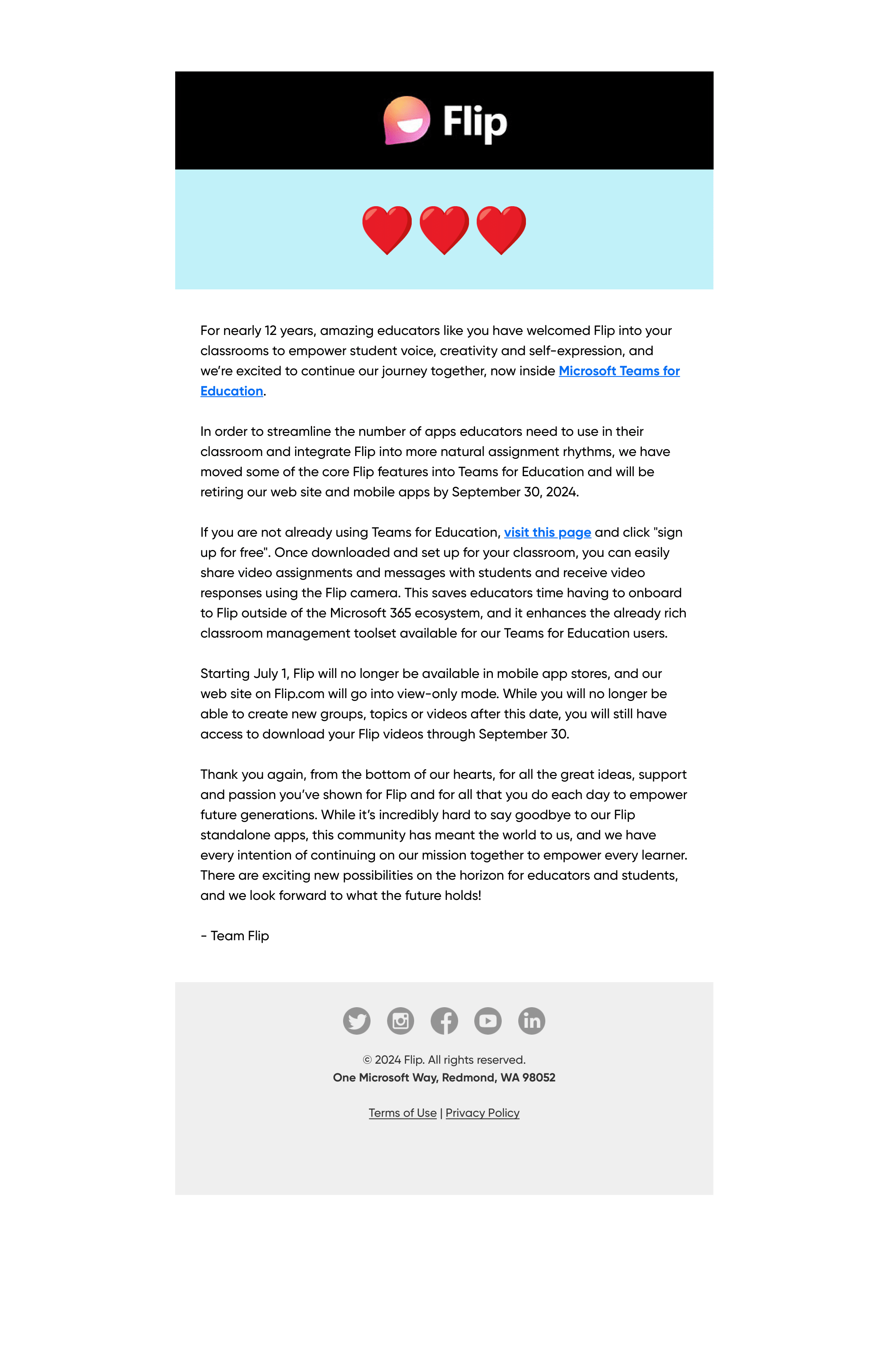
Online Course: Coding in the Elementary Grades #tcea #tceajmg
👾 Introduce coding to young minds with our “Coding in the Elementary Grades” course! Learn to adapt tools and resources for your classroom, both online and offline. Start building your coding capacity today!
👉 tcea.org/courses/coding-elementary/
Linkshare: ChatGPT EDU for Higher Ed
ChatGPT Edu, a version of ChatGPT built for universities to responsibly deploy AI to students, faculty, researchers, and campus operations. Powered by GPT-4o, ChatGPT Edu can reason across text and vision and use advanced tools such as data analysis. This new offering includes enterprise-level security and controls and is affordable for educational institutions.
via OpenAI
Online Course: Choice Boards for Educators #tcea #tceajmg
🎨 Unleash your inner choice board genius with our “Choice Boards for Educators” course! Learn to create effective, differentiated choice boards that promote student choice and voice.
👉 tcea.org/courses/choice-boards/
TCEA Announces Network Security Course #tceajmg #tcea
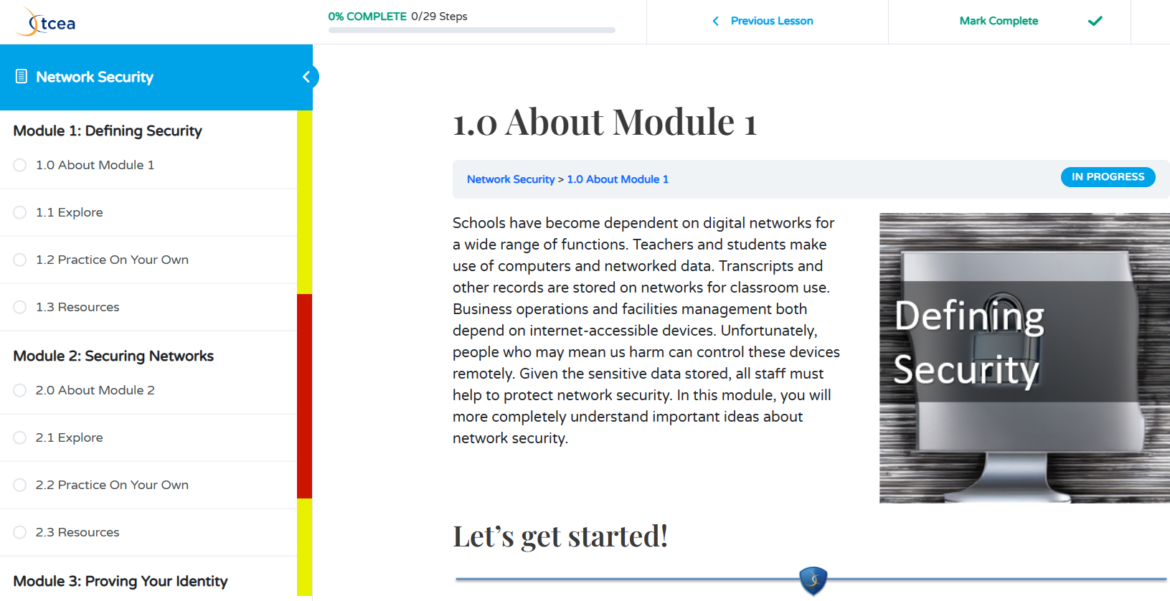
Check out a brand new Network Security course from TCEA! Learn about security tools, good practices, and avoiding attempts to trick you. School technology support staff now have access to a network security course! The online, self-paced course is available through TCEA. The course, Network Security, prepares technology support staff through a presentation of network threats and risks they will encounter.
Online Course: ChatGPT for Educators #tcea #tceajmg
🚀 Embark on an adventure with our “ChatGPT for Educators” course! Master prompt engineering, enhance lesson planning, and explore new AI strategies. Expand your educational toolkit today!
👉 tcea.org/courses/chatgpt-for-educators/
How to Easily Convert Quizzes Between Platforms #tcea #tceajmg
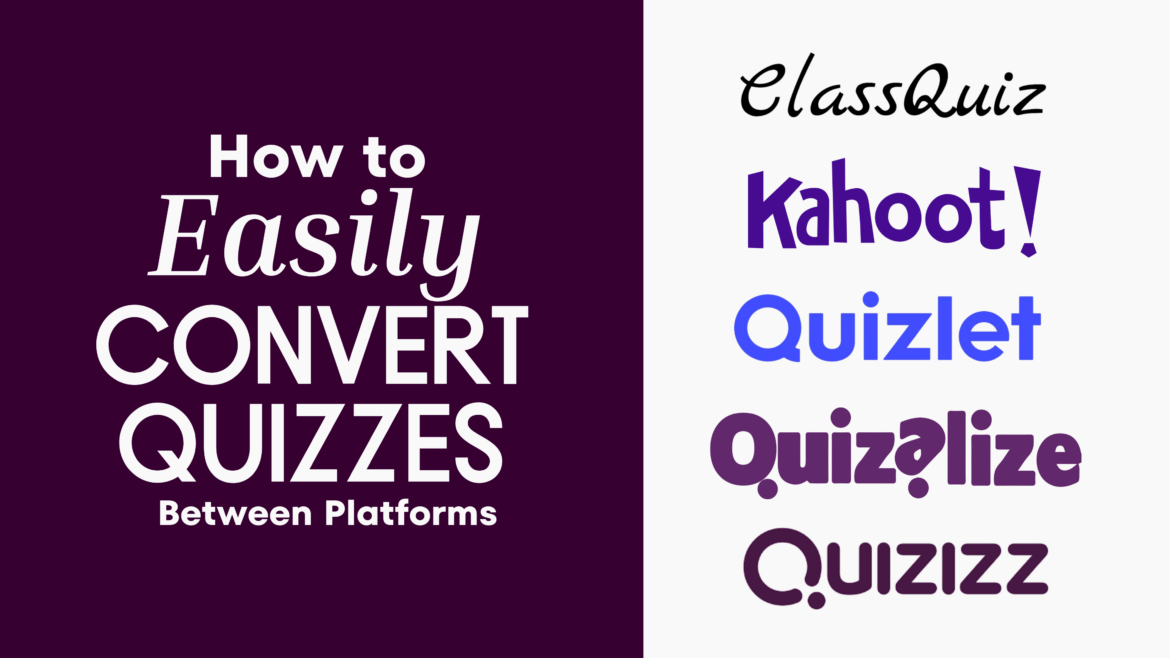
Need to get a set of quiz questions from one system (e.g. Quizlet, Kahoot!) into another? Find out how to convert quizzes easily! Are you an online quiz user? Not the social media quiz kind, but the teacher who uses tools like Quizlet, Kahoot!, Quizizz, and others? While quiz questions are often available in various places, they may not be on the platform you want them to be in. How do you get a quiz from Quizlet Flashcards into Kahoot!? Or a quiz from Kahoot! into ClassQuiz? Let’s learn how to convert from one quiz maker to another and how to export and import questions. We’ll walk through the following actions, and you can feel free to jump to any section that will meet your needs.
AI Tools List #AItools EdTech #tceajmg
Exploring the world of AI tools is like diving into a treasure chest of drill bits! 💡 From lesson planning to email management, there’s a tool for every need. Want to know my top picks? Scroll to the end of the blog! Bookmark for daily updates on the latest in AI. 🔖
Read more here
Online Course: Canvas Educator #tcea #tceajmg
📚 Master the Canvas LMS with our Canvas Educator course! Learn to create, customize, and integrate digital tools for engaging lessons. Self-paced and flexible for busy educators.
